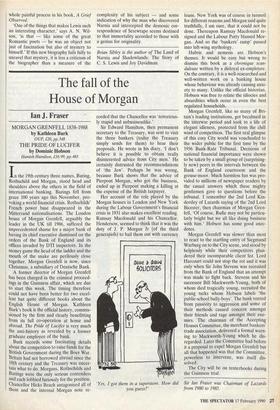The fall of the House of Morgan
Ian J. Fraser
MORGAN GRENFELL 1838-1988 by Kathleen Burk OUP, £20, pp.348 THE PRIDE OF LUCIFER by Dominic Hobson Hamish Hamilton, £16.99, pp.483 In the 19th century three names, Baring, Rothschild and Morgan, stood head and shoulders above the others in the field of international banking. Barings fell from grace 100 years ago this November, pro- voking a world financial crisis. Rothschilds' French power base disappeared in the Mitterrand nationalisations. The London house of Morgan Grenfell, arguably the leader in the UK till 1986, suffered the unprecedented shame for a major bank of having its chief executive dismissed on the orders of the Bank of England and its offices invaded by DTI inspectors. In the money game the head of the ladder and the mouth of the snake are perilously close together. Morgan Grenfell is now, since Christmas, a subsidiary of Deutsche Bank.
A former director of Morgan Grenfell has been charged in the criminal proceed- ings in the Guinness affair, which are due to start this week. The timing therefore could not have been better for two excel- lent but quite different books about the English House of Morgan. Kathleen Burk's book is the official history, commis- sioned by the firm and clearly benefitting from its full co-operation at home and abroad. The Pride of Lucifer is very much the anti-history as revealed by a former graduate employee of the bank.
Burk records some fascinating details about the competition to raise funds for the British Government during the Boer War. Britain had not borrowed abroad since the 18th century and the Treasury was uncer- tain what to do. Morgans, Rothschilds and Barings were the only serious contenders and each lobbied furiously for the position. Chancellor Hicks Beach antagonised all of them and the internal Morgan note re-
corded that the Chancellor was 'notorious- ly stupid and unbusinesslike.'
Sir Edward Hamilton, then permanent secretary to the Treasury, was sent to visit the three bankers (today the Treasury simply sends for them) to hear their proposals. He wrote in his diary, 'I don't believe it is possible to obtain really disinterested advice from City men.' He certainly distrusted the recommendations of 'the Jew'. Perhaps he was wrong, because Burk shows that the advice of Pierpont Morgan, who got the business, ended up in Pierpont making a killing at the expense of the British taxpayer.
Her account of the role played by the Morgan houses in London and New York during the Labour Government's financial crisis in 1931 also makes excellent reading. Ramsay Macdonald and his Chancellor, Henderson, seemed to think that it was the duty of J. P. Morgan Jr (of the third generatiOn) o bail them out with currency
'Yes, I got them in a superstore. How did you guess?' loans. New York was of course in turmoil for different reasons and Morgan said quite truthfully, I am sure, that it could not be done. Thereupon Ramsay Macdonald re- signed and the Labour Party blamed Mor- gan. And so the 'bankers' ramp' passed into left-wing mythology.
Hubris and nemesis are Hobson's themes. It would be easy but wrong to dismiss this book as a ehronique scan- daleuse written by a disloyal ex-employee. On the contrary, it is a well-researched and well-written work on a banking house whose behaviour was already causing anxi- ety to many. Unlike the official historian, Hobson was free to relate the idiocies and absurdities which occur in even the best regulated households.
Morgan Grenfell, like so many of Bri- tain's leading institutions, got becalmed in the interwar period and took to a life of elegant idleness, protected from the chill wind of competition. The first real glimpse of this cosy City world was vouchsafed to the wider public for the first time by the 1956 Bank-Rate Tribunal. Decisions of national financial importance were shown to be taken by a small group of (surprising- ly new) peers in the intervals between the Bank of England courtroom and the grouse-moor. Much harmless fun was pro- vided to millions of newspaper readers by the casual answers which these mighty gentlemen gave to questions before the tribunal. I remember the 2nd Lord Kin- dersley of Lazards saying of the 2nd Lord Bicester, then chairman of Morgan Oren- fell, 'Of course, Rufie may not be particu- larly bright but we all like doing business with him.' Hobson has some good anec- dotes.
Morgan Grenfell was slower than most to react to the startling entry of Siegmund Warburg on to the City scene, and stood by helplessly while their competitors plun- dered their incomparable client list. Lord Harcourt could not stop the rot and it was only when Sir John Stevens was recruited from the Bank of England that an attempt was made to fight back. Stevens and his successor Bill Mackworth-Young, both of whom died tragically young, recruited the young turks whom Hobson labels 'the public-school bully-boys'. The bank veered from passivity to aggression and some of their methods caused concern amongst their friends and rage amongst their ene- mies. The chairman of the Accepting Houses Committee, the merchant bankers' trade association, delivered a formal warn- ing to Mackworth-Young which he dis- regarded. Later the Committee had before it a proposal to expel Morgan Grenfell but all that happened was that the Committee, powerless to intervene, was itself dis- solved.
The City will be on tenterhooks during the Guinness trial.
Sir Ian Fraser was Chairman of Lazards from 1980 to 1985.


















































 Previous page
Previous page